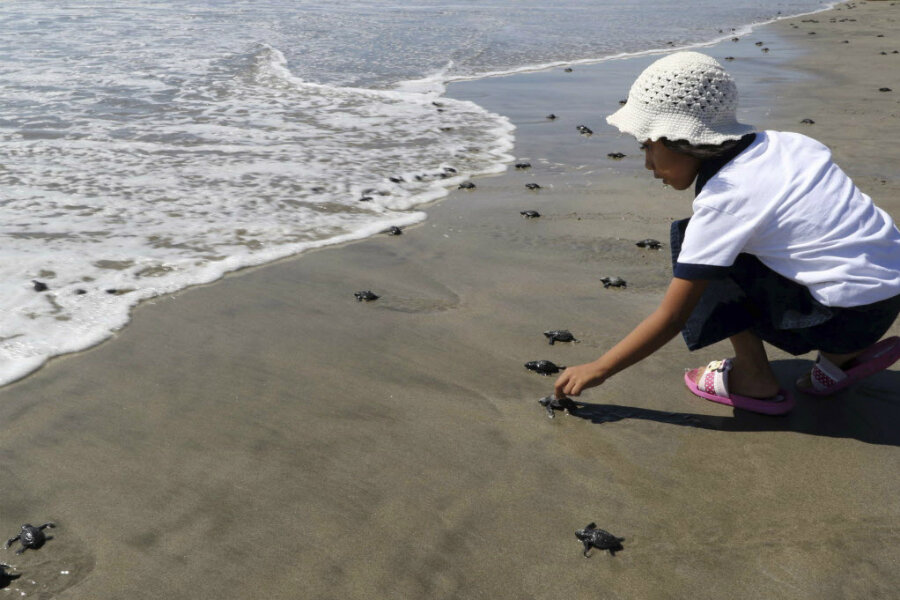Mexico jumps on the 'big reserve' trend of ocean conservation
Loading...
On Monday, the Mexican government established the largest biological reserve in the country’s history, further driving a global trend of setting aside large swaths of land and ocean for conservation.
In a signed decree, President Enrique Peña Nieto set aside 160 million acres of conservation area. The Mexican federal government will safeguard four new reserves and five protected areas, from Pacific Island waters to the Mountains of Tamaulipas, to retain biodiversity in those regions.
By designating 23 percent of its sea surfaces as protected, Mexico has surpassed United Nations' “10 percent target” three years ahead of schedule. In doing so, the country joins a growing list of nations to commit vast marine resources to conservation.
Large marine protected areas (MPAs) are a relatively new trend in global environmentalism. When the United Nations Convention on Biological Diversity met in 2010, just 1 percent of the world’s oceans were federally protected. That year, 196 countries signed off on a deal to designate 10 percent by 2020.
Today, the island country of Palau protects some 80 percent of its marine waters, drastically overshooting the UN target. And in August, President Obama expanded the Papahānaumokuākea Marine National Monument to 582,578 square miles, nearly quadrupling its original size.
“It’s internationally agreed that this is a justifiable or even achievable goal,” Randall Kosaki, NOAA's deputy superintendent of Papahānaumokuākea, tells the Monitor in a phone interview. “If you plot out that trajectory over time, it won't be met until 2060. But with the inclusion of these so-called jumbo MPAs, we may hit the goal as early as 2025.”
The Papahānaumokuākea reserve, located in the Northwestern Hawaiian Islands, was the largest ecological sanctuary on the planet – that is, until a multinational council designated Antarctica’s Ross Sea as a protected area in October.
The Christian Science Monitor’s David Iaconangelo reported:
The Ross Sea will be designated a "no-take" zone, putting everything from minerals to marine life off limits to extraction. It’s a jewel of biodiversity and a refuge for many species whose numbers are in decline elsewhere. About half of the world’s type C killer whales live there, along with 40 percent of Adelie penguins, 30 percent of Antarctic petrels, and 25 percent of emperor penguins, according to the United Nations commission for marine conservation.
As countries like Mexico and Palau meet or even exceed UN targets, two or three new MPAs are coming online every year. But until recently, most new designations have been in the tropics – something of a diversity problem for globally-minded conservationists.
“That 10 percent goal should include every suite of ocean habitat,” Dr. Kosacki says. “We need to go beyond the coral reefs, and this is a huge step in that direction.”
A sense of new urgency may drive these designations. Oceans have absorbed more than 90 percent of the excess heat from anthropogenic warming since the 1970s, according to an IUCN report. Meanwhile, overfishing and offshore drilling have put additional stress on marine ecosystems already subject to acidification. And though 12 percent of the planet’s land areas are designated reserves or national parks, less than 5 percent of oceans are protected.
That urgency has produced a kind of "race" for the largest MPA, notes Noella Gray, a professor of political ecology at the University of Guelph in Ontario. But the effectiveness of this approach is not universally accepted.
"Critics suggest many of these sites are 'paper parks' – lines on a map that have no conservation impact – and that the focus on quantity over quality does not support more sustainable management," Dr. Gray tells the Monitor in an email. "Overall, there is still much we do not know about the [social, economic, and ecological] impacts and outcomes of large MPAs – it will be important to monitor these impacts moving forward.
Politics can also complicate reserve designation, especially since many marine ecosystems are located outside the jurisdiction of any single nation. Even still, MPAs may prove crucial to both the health of our oceans and the public’s understanding of them.
“They’re good as conservation tools, but they’re even better as outreach tools,” Kosaki says. “I think we’ll never have enough MPAs to save the oceans, but these can stress… that the plastic water bottle you're using in Kansas, or that gas guzzler you’re driving, is impacting marine ecosystems thousands of miles away.”
“I really think this is an idea whose time has come.”






